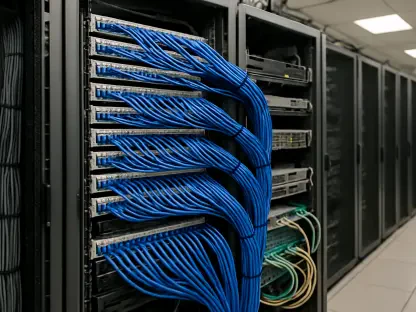As edge computing continues to evolve, adapting to changing dynamics and demands becomes critical for industry players. Edge computing’s growth trajectory necessitates strategic shifts, focusing not only on latency and geographic proximity but increasingly on population density to maximize return on investment (ROI). This new perspective, rooted in addressing the needs of densely populated areas, transforms traditional models and highlights urban-centric strategies. The conversation around edge computing now revolves around identifying optimal locations that cater to sprawling population clusters rather than merely focusing on reducing latency through geographic proximity. Stakeholders in the computing market must now consider factors like urbanization and demographic growth patterns as major determinants of success. By strategically locating data centers where the bulk of populations resides, businesses can deliver consistent digital experiences, driving customer satisfaction and ultimately enhancing profitability.
The Analogies Between Real Estate and Edge Computing
Integral Role of Strategic Positioning
Drawing parallels between traditional real estate markets and data centers at the edge reveals an evolved focus. While geographical location is paramount in real estate valuation, the edge computing industry increasingly prioritizes population proximity over mere geographical placement for maximizing ROI. When assessing the similarities, strategic positioning in densely populated regions emerges as a vital component for success. Just as prime real estate locations attract higher valuations and desirability, edge data centers must be strategically situated within or proximate to dense population clusters. This paradigm ensures the efficient delivery of digital services and the fast, reliable connections that modern consumers expect.
Meeting Customer Expectations
Positioning data centers near population hubs is crucial for addressing the heightened expectations of today’s tech-savvy customers. This alignment negates potential latency challenges that can arise from infrastructure located far from end-users. By being positioned near population densities, edge providers can offer seamless, always-on digital experiences. This proximity also facilitates better disaster recovery capabilities and enhances data sovereignty, catering to the needs of businesses in various sectors. Moreover, consumers demand rapid access to information, entertainment, and services. Locating data centers closer to them provides edge computing stakeholders an opportunity to meet these demands efficiently and effectively, driving customer retention.
Growth Trajectory of Edge Computing
Impressive Market Expansion
The edge computing market’s growth highlights a transformation in digital infrastructure management paradigms. Current projections indicate staggering growth, predicting the market’s value will leap from $16.45 billion to $155.9 billion by 2030, illustrating the industry’s rapid expansion and maturation. In 2025, roughly 75% of new data is anticipated to be generated outside conventional central data centers, suggesting widespread adoption of edge computing models. Such growth underscores the need for strategic adaptation to meet evolving consumer demands and technological advancements effectively. One contributing factor to this growth is the increasing volume and complexity of data, which pushes companies to reconsider where and how they store, process, and analyze information.
Strategic Considerations Beyond Latency
Tapping into the potential of edge computing requires redefining strategic priorities and considerations. Before the widespread proliferation of internet-connected devices, latency was the sole metric driving strategic decisions for data center placement. Now, population density has emerged as a primary consideration with the objective of bringing businesses closer to their consumers. This shift away from singular dependence on latency is supported by the immense growth predictions for the market, necessitating data center placement within or close to population centers. Proximity to consumers and businesses significantly enhances the ability to deliver high-quality, rapid digital experiences required in a competitive landscape.
Economic Complexities Faced by Hyperscalers
Balancing Scale and Cost Challenges
Hyperscalers like AWS, Microsoft, and Google face notable challenges in scaling to meet the demand in dense urban environments. Their strategy, built on a model driven by scale efficiencies, requires large facilities with vast footprints. They often opt for rural or suburban locations where land and power costs are lower, mitigating elevated costs incurred in urban centers. However, this approach may distance these providers from the urban consumer base, impacting their ability to efficiently serve densely populated areas. The complexities of urban infrastructure, including regulatory hurdles and increased operational costs, often deter hyperscalers from centering their infrastructure in city environments.
Dilemmas in Urban Positioning
The economic dilemma of balancing costs with the benefits of proximity to urban centers necessitates innovative approaches. Given that urban locations come with unique challenges, including higher real estate prices and intricate power infrastructure requirements, hyperscalers often prioritize areas offering more economically favorable conditions. In contrast, urban-centric positioning aligns more closely with the strategy needed to serve dense population clusters effectively. Current complexities in urban infrastructure often restrict hyperscalers from capitalizing on urban consumer bases, emphasizing the need for innovative strategies. While widespread, rural-centric strategies provide scale, they require complementary urban approaches to address city-based consumer demands comprehensively.
Colocation as an Economic Solution
Multi-Tenancy Economic Viability
Colocation data centers serve as a solution to the economic and logistical complexities presented by urban locations. Unlike hyperscalers, colocation providers achieve economies of scale through multi-tenancy—spreading real estate and infrastructure costs across multiple clients within a single facility. This economic model enables colocation centers to operate near population hubs, absorbing high costs while providing dedicated services. This setup opens doors for businesses needing to ensure reliable operations within dense population areas without the burden of independent infrastructure costs. Shared infrastructure enhances agility, allowing faster adaptation to technological advancements, improving scalability without a substantial financial burden.
Location Services Aligned with Population Needs
Colocation centers utilize strategic placements to maintain proximity to their customer bases, demonstrating a pattern of capitalizing on geographic and demographic shifts. Their infrastructure is tailored to meet specific demographic needs, ensuring rapid data processing and storage capabilities. Providers strategically place facilities near urban epicenters, offering businesses access to shared resources, which enhances efficiency. Additionally, colocation centers leverage their ability to access urban demographics, demonstrating scalability and adaptability in deploying facilities in emerging markets. This ensures access to advanced technology while maintaining optimization in operational expenses, allowing businesses to maximize the benefits of trend-driven growth opportunities.
Strategic Implications of Population-Centric Models
Physical Infrastructure Enhancement
The ongoing trend in edge computing focuses on population-centric models, demanding physical infrastructure enhancement. While hyperscalers manage widespread virtualized solutions, colocation providers prioritize strategically located physical facilities. These efforts underscore an industry-wide shift towards ensuring infrastructure is within reach of populous clusters. Colocation sites tailored to meet demographic requirements facilitate rapid data access, reducing latency from distant digital exchanges. Aligning physical asset deployment closer to consumers bolsters competitive advantage, positioning businesses effectively to meet digital demands of a growing population-oriented economy.
Market Trend Convergence
Industry trends highlight a convergence of strategies aligned with population-centric models, proving beneficial for stakeholders. Well-situated infrastructure, close to consumers using data-intensive applications, presents opportunities for increased capacity and capabilities. This strategic positioning fosters improved market responsiveness, enabling businesses to harness demographic potential with broader reach. While hyperscalers excel at virtualized, widespread coverage, colocation providers distinguish themselves through concentrated deployments. These population-centric strategies exhibit intricate knowledge of evolving urban dynamics, reflecting an industry-wide transition towards maximizing coverage through demography-focused solutions.
Insights into Future Edge Computing
As edge computing evolves, keeping up with changing demands and dynamics is crucial for industry players. The growth of edge computing has spurred strategic shifts, concentrating not just on latency and geographic closeness but increasingly on population density to maximize return on investment (ROI). This new approach, focused on meeting the needs of densely populated areas, reshapes traditional models and underscores urban-focused strategies. The current focus in edge computing involves pinpointing ideal locations to serve large population clusters rather than just lowering latency through geographic nearness. Computing market stakeholders must now account for urbanization and demographic trends as key factors in their success. By placing data centers strategically in areas with higher populations, businesses can ensure consistent digital experiences, enhance customer satisfaction, and ultimately boost profitability. As digital interactions grow more ubiquitous, the ability to anticipate and respond to these population-driven demands will define competitive advantage in the edge computing realm.









